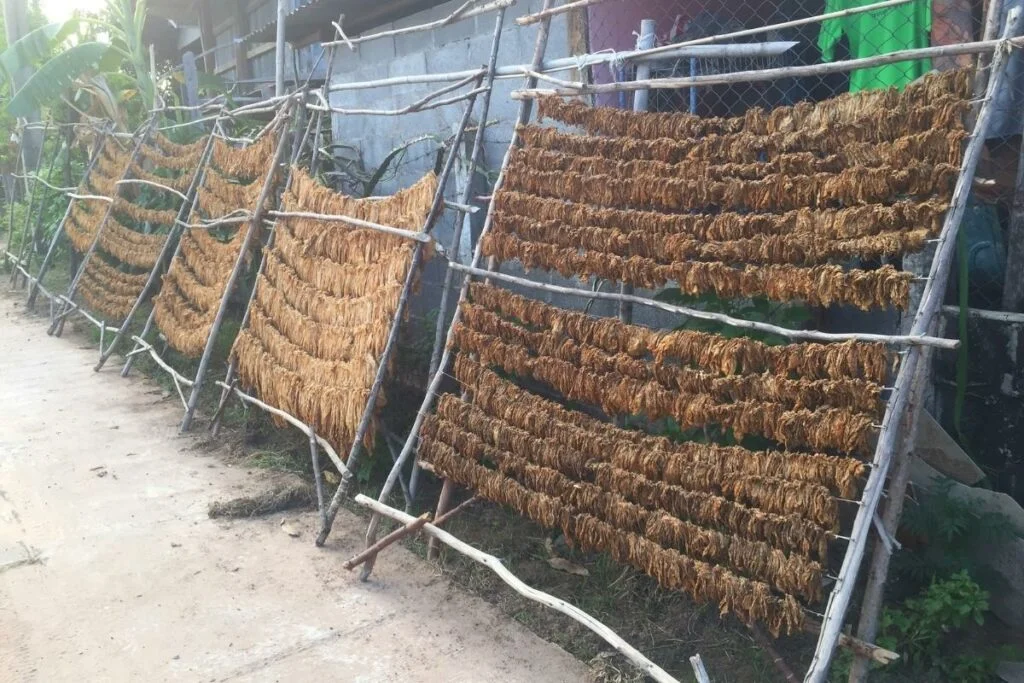Flue-curing
- Flue means the passage of hot air blow.
- The main objective of flue-curing is to keep the leaf alive until almost all the starch is converted to sugar and to kill it before any appreciable amount of these sugars are oxidized.
- Flue-curing is the process of curing by exposure to indirect heat, created by moving hot air, through a flue or pipe.
- Higher heat causes more rapid drying and is the traditional way to cure Virginia tobacco.
- Flue-cured tobacco generally, has more sugar, less oil and lower nicotine content. Because of the ability of this curing method to fix appreciable amount of sugars, a form of flue-curing is used in making ‘candela’ (green cigar wrapper).
- Flue-curing is usually done in brick barns, the distinctive features being the system of large pipes that carry off the fuel gases so that the smoke doesn’t come in contact to the tobacco leaves.
- There is an absolute control of temperature and relative humidity in the barn.
- In Nepal, the barns are mostly 4.9×4.9×4.9 m3 and 7.3×4.9×3.2 m3 with the capacity of 700 and 800 sticks respectively.

a. Yellowing of leaf
- A temperature ranging from 26-28.3oC is kept for the first 12 hours.
- Raised to 36.6oC for the next 6-7 hours for the yellowing of the leaf.
- After that, the temperature of 36.6-37.7oC is used for 12-15 hours when the leaves become yellow.
- Thus, it is a slow starving process with an objective to give optimum humidity (85%) and retain as much moisture as possible to keep the leaves alive for 30-36 hours.
- This process takes about 50 hours and results in bright lemon-yellow colored leaves.
b. Fixing the color
- After yellowing, the temperature is raised from 37.7oC to 48.8oC but the humidity of the barn is lowered by ventilator in order to kill the leaf, destroy the enzymes and dry out the web of the leaf.
- The moisture coming out of the leaves are taken care by the ventilator (which are half open at first and then fully opened later).
- About 80% of the moisture is driven off.
- Raising the temperature requires a great care; the temperature must be raised by not more than 1oC every hour.
- Rapid rising of temperature when the leaf is still wet results in bluish-black coloration called ‘scalding’.
- It takes about 16-24 hours.
c. Drying of leaf
- It is the final stage in flue-curing where the ventilators are closed and the temperature is raised up to 74oC in order to dry the veins and mid-rib.
- The leaves are killed during this stage while the RH drops to less than 10%.
- It lasts from 28-50 hours.
- After this, the ventilators are opened to cool down the barn, the leaves are left in barn overnight to allow moisture to be absorbed and come to normal condition for handling and storage.
- Flue-curing takes about 5-6 days.
- For flue-curing, the leaves are harvested by priming method, so that the translocation of sugars from leaves to the stalk doesn’t occur during curing.
- A good bodied, bright nitrogenous compounds produced by flue-curing.
- lemon-colored leaves rich in sugar and poor in (the most desired quality of cigarette tobacco).